This was published 2 years ago
How the healthiest koala colony collapsed into extinction
Calamity has struck the koalas of Gunnedah, the NSW town that still calls itself the “koala capital of the world”.
By Nick O'Malley and Wolter Peeters
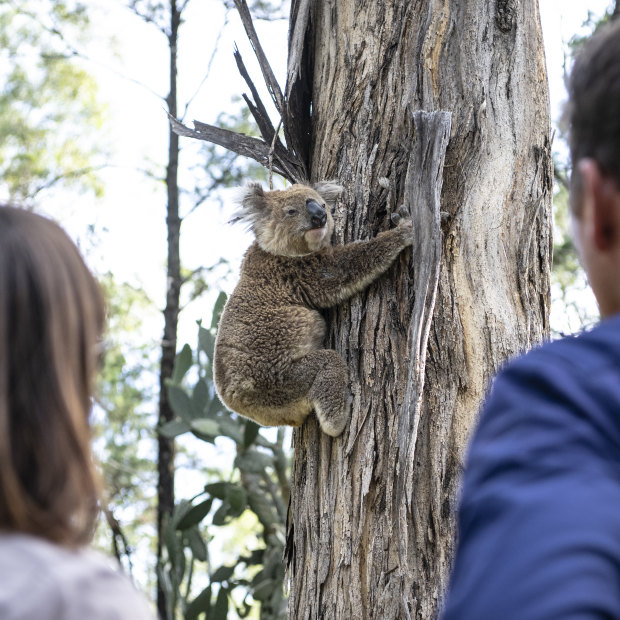
A koala is released after its tracking collar was removed.Credit: Wolter Peeters
The safest way to extract a recalcitrant koala from the top of a tall tree, it turns out, begins with a slingshot.
Early one morning in late March, Ben Richardson, an arborist by trade and rock climber by choice – when he is not bothering koalas – gives a masterclass in the technique.
A group of University of Sydney scientists huddle among the bracken and fallen logs in a strip of trees that run along a dry creek bed alongside a cleared paddock on a farm just outside Gunnedah.
Richardson leans back against a thick log, props up a pole that is nearly his own height, squats and pulls back a metre or so on the elastic sling.
A beanbag the size of his fist tethered to a light nylon line shoots up and arches over a bough around 10 metres or so up the tree on the far side of the koala.
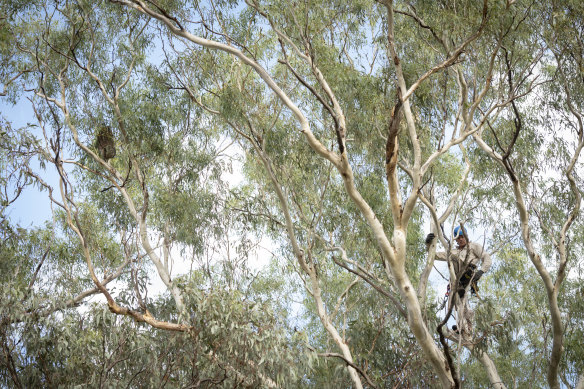
Ben Richardson climbs after a koala so scientists can complete a sad task.Credit: Wolter Peeters
The animal, which to this point had been ignoring the hushed commotion beneath it, begins climbing higher.
“It’s not stupid,” mutters one of the scientists squatting in the bracken. “We’ve already caught it half-a-dozen times before.”
The animal, which they know simply as 28f, had been efficiently located minutes earlier by Associate Professor Damien Higgins, who had marched across the field with an antenna that looked like something your parents might have used to watch telly, linked to a beeping tracking device. Poor old 28f had been betrayed, again, by the radio collar she has been wearing these past few years.
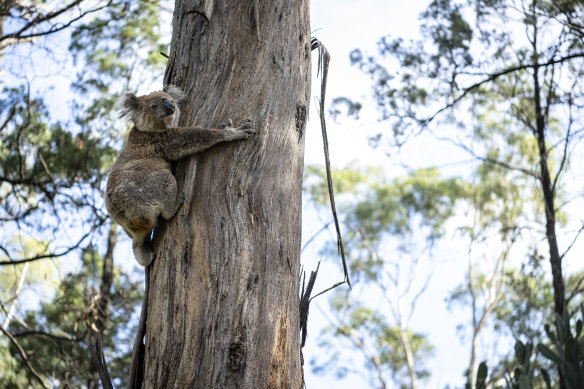
A koala grips on to a tree in Gunnedah.Credit: Wolter Peeters
Richardson, whose technique has been vetted by a University of Sydney ethics board, gathers up the nylon line and pulls a thick rope up the tree after it, and proceeds to climb it.
The koala groans audibly and climbs to the very crown, clinging to branches she must know are far too thin to support the predator beneath.
Richardson isn’t done. Now beneath the animal, he hauls a telescopic pole adorned with coloured scarfs at its tip from his kit. It gives him an extra few metres’ reach, which he uses to wave the fabric above the animal’s head.
Koalas are conditioned to respond to threats from above, and soon 28f descends, grunting and grumbling and grunting all the way to the ground.
The team leaps into smooth and quiet action.
28f is given a sedative to relieve the stress of the encounter and tucked into a canvas sack marked with an Australia Post logo and the warning, “Misuse of this bag is a criminal offence.”
Rob Frend, a retired local farmer who has worked closely with the team for years, hoists the bag gently over his shoulder and strides to a lab set up at the rear of a four-wheel drive waiting nearby.
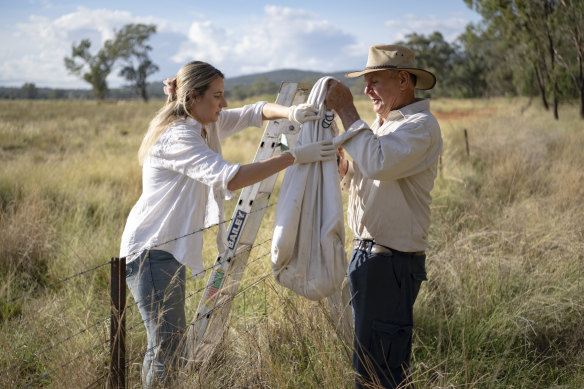
Farmer Robert Frend passes a bagged koala to vet Sarah Simpson.Credit: Wolter Peeters
Sarah Simpson, the group’s veterinarian, administers an anaesthetic via a facemask. Alana Kidd, a PhD student specialising in genetics, starts running a battery of tests. Blood is taken, as are swabs of the nose, eyes, mouth and urogenital tract.
The animal, which had looked like something out of a storybook when sitting in the bow of the gum, a soft blob atop its beautifully rounded bum, has a far more substantial presence up close.
She weighs 8.25 kilograms and is the size of a large dog. Her worn teeth mark her as close to middle-aged. The double thumbs on her fore and rear paws look powerful even in her torpor.
She is strong and reasonably fit, though the stains on her bottom suggest she has been suffering from chlamydia, the sexually transmitted disease that is attacking so many koala populations.
An ultrasound shows large cysts on both ovaries. The disease has rendered her infertile. “Painful?” I ask Simpson.
“Probably.”
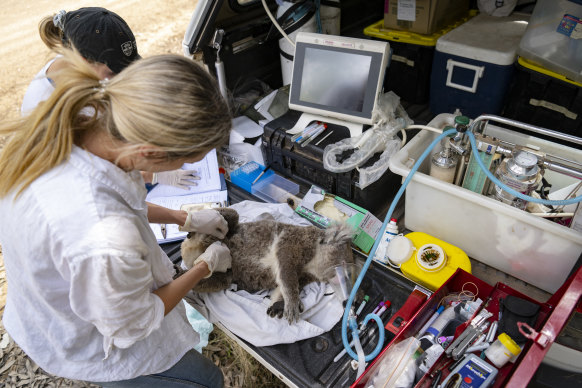
Vet Sarah Simpson (right) and doctoral student Alana Kidd run tests on a koala.Credit: Wolter Peeters
The tests completed, Simpson cuts off the animal’s radio collar and drives the lab off through the paddocks to a different location where Higgins has already located another animal with his beeping wand and Richardson is preparing his gear for another climb.
It is gruelling and sad work.
Frend sits quietly with the 28f, waiting for her to recover from the anaesthetic so he can carry her gently back to her tree.
She can’t know that this will be the last time she will suffer these indignities, just as she can’t know of the calamity that has struck the koalas of Gunnedah, the New South Wales town that still calls itself the “koala capital of the world”.
Bucking the trend
It was the now-retired University of Sydney professor Dan Lunney who attracted koala specialists to this part of the world.
Back in the late 1990s and again in the 2000s, he conducted a pair of studies with remarkable findings. While koala populations up and down the east coast were falling, those around Gunnedah were thriving.
What was even more remarkable was that they were thriving in a landscape that had already been thoroughly carved up by modern agriculture and even mining. Yet on a remnant patchwork of feed and habitat trees, observations by local farmers collected and analysed by Lunney demonstrated that the population was healthy and growing.
Ever since the mass slaughter of koalas that continued into the 1930s, ecologists studying koalas in NSW and Queensland have mostly been observing an animal in decline.
Sadly for the koala, it tends to thrive in the landscapes that are favoured by people. Koalas have been displaced by urban development, logging and agriculture up and down the east coast.
That is what made this growing inland population so intriguing, and led other scientists to follow Lunney to Gunnedah – people like Professor Mark Krockenberger, who leads the research we observed, and his colleague, Dr Valentina Mella.
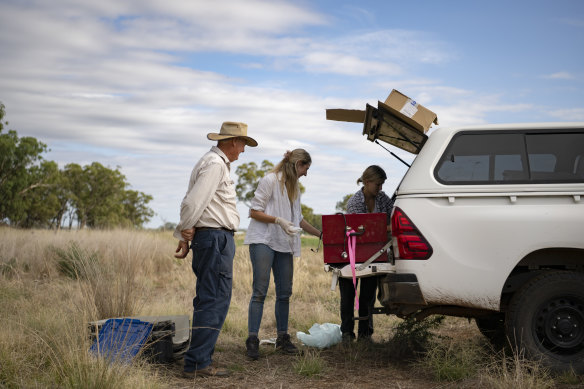
Local farmer Robert Frend looks on as vet Sarah Simpson and PhD student Alana Kidd inspect a koala. Credit: Wolter Peeters
Lunney’s research suggested that a massive tree-planting program conducted in and around Gunnedah in the 1990s to combat a growing salinity problem had the unintended consequence of boosting koala numbers in the 2000s. If this was the case, scientists wanted to know how they might replicate the effect.
In 2012, the Australian Geographic magazine ran a story optimistically entitled “Gunnedah may hold key to reversing koala decline”.
And for a long time that seemed to be true but even then, there were dark signs of things to come.
Frend remembers how during one long heatwave, a quarter of the animals that had been recruited to one study simply died.
“The scientist were near tears,” recalls Frend. “It was a real kick in the guts.”
Over the years that followed, the landscape dried out, nutrient levels in koala feed trees fell, and the population began to decline.
Frend, who had begun to work more closely with the scientists and despaired at the state of the animals, became convinced that the belief koalas did not drink, absorbing all the moisture they needed from gum leaves, was wrong.
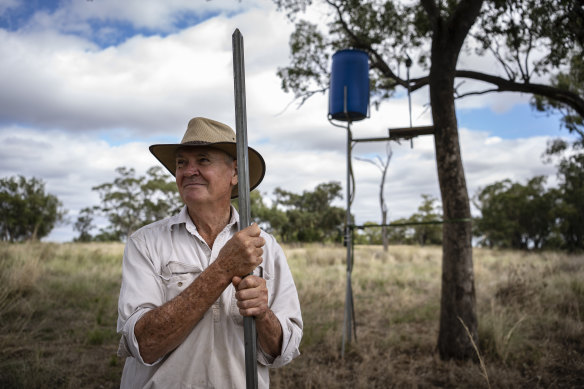
Rob Frend helped devise a water feeder for koalas.Credit: Wolter Peeters
“They were literally dying trying to tell us that they needed help, and we were not listening.”
Mella, who grew up in Italy before studying in Australia, came to agree with him and set about proving it. In 2016, the two began putting water out at feed trees under trail cameras and proved that koalas did indeed drink. That research has led to Frend’s creation of specialist drinking troughs that sit high in habitat trees. The troughs can be seen around Gunnedah and are now being mass-produced to be deployed across the country before the coming summer that some fear will be particularly hot.
Mella and the gentle old farmer have developed what he calls a father-daughter relationship over the years and are quick to credit one another with the breakthrough, but Mella can’t help boasting that it took an Italian to make a basic discovery about Australia’s favourite animal.
In any event, it wasn’t just the heat and lack of water that began killing off Gunnedah’s koalas.
A tipping point
By 2015, Mella and Krockenberger began to notice that the rate of chlamydia infection in the animals in their study had begun to leap from an estimated 10 per cent the previous decade.
Mella remembers a moment during a field trip the following year when Krockenberger turned to her and said bluntly, “These animals are f--ked.”
Krockenberger explains: “I think what I was seeing was a tipping point where we had found something like 60 or 70 per cent of the population now infected with chlamydia.
“And once you get to that sort of level, it’s very hard to maintain population numbers because each of those infected animals either is infertile or will very soon be infertile.
“If your breeding population shrinks from 100 per cent, down to 30 per cent, over a period of two or three years, that’s not a sustainable pathway.”
Frend was seeing a similar collapse in numbers on his farm. In 2016, there were 30 koalas on a 370-hectare section of his land. He hoped that by installing water troughs he might be able to boost that number. Today, there are three.
Chlamydia is thought to have been introduced to koalas via sheep and cattle. Two strains are known to be attacking Gunnedah’s koalas. The disease spreads rapidly via mating or being passed on from mother to joey via feeding.
Krockenberger explains that the impact of the disease has likely been compounded by other factors, particularly a climate that is growing inexorably hotter and drier. Animals that are stressed, or suffering from dehydration and malnutrition, he explains, are less resilient and more susceptible to the spread and impact of disease.
Over recent years, the focus of research on the Gunnedah koalas shifted from how the population interacted with agricultural activities to how the disease was spreading.
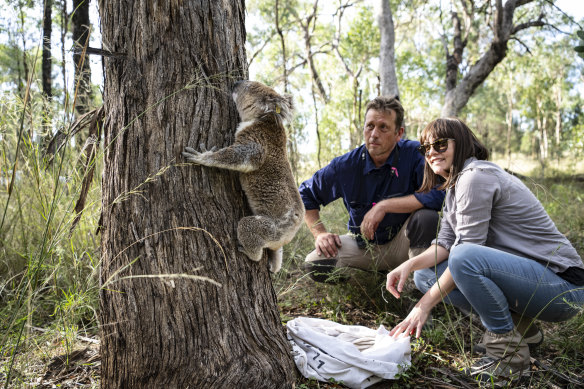
Professor Mark Krockenberger and Dr Valentina Mella release a koala to the tree it was caught from.Credit: Wolter Peeters
Krockenberger and his team began testing a vaccine that had been developed by Professor Peter Timms at the University of the Sunshine Coast.
The results of the research have yet to be published but over recent months, it became clear to Krockenberger that the Gunnedah koala population, once the hope for the future of the animal, was functionally extinct. Those animals alive today are likely to live out their lives but few, if any, young will be born.
As a result, the research project has ended, which is why Krockenberger and his team were in Gunnedah last month.
The animals in the study are now so old, the age distribution of the colony so unrepresentative, that it risks skewing the results of the vaccine research.
Over the course of three days, they capture 30 koalas. One of them is a young female who over the past two years had delighted the researchers by rearing two healthy joeys. She is now infertile.
At one point as the sun lowers and the team takes a break, Mella inspects the bag of radio collars that have been removed from the koalas over the day and wonders aloud if they might be repurposed for another study elsewhere.
An hour or so after her tests are completed, 28f is alert enough for release.
Frend lays his canvas sack gently at the base of the giant white box gum tree in which she had been captured.
She pokes her head up, gives him a woozy glare, and makes a half-hearted attempt to climb a nearby sapling before giving up on the effort and scampering off into the bush.
Get to the heart of what’s happening with climate change and the environment. Our fortnightly Environment newsletter brings you the news, the issues and the solutions. Sign up here.